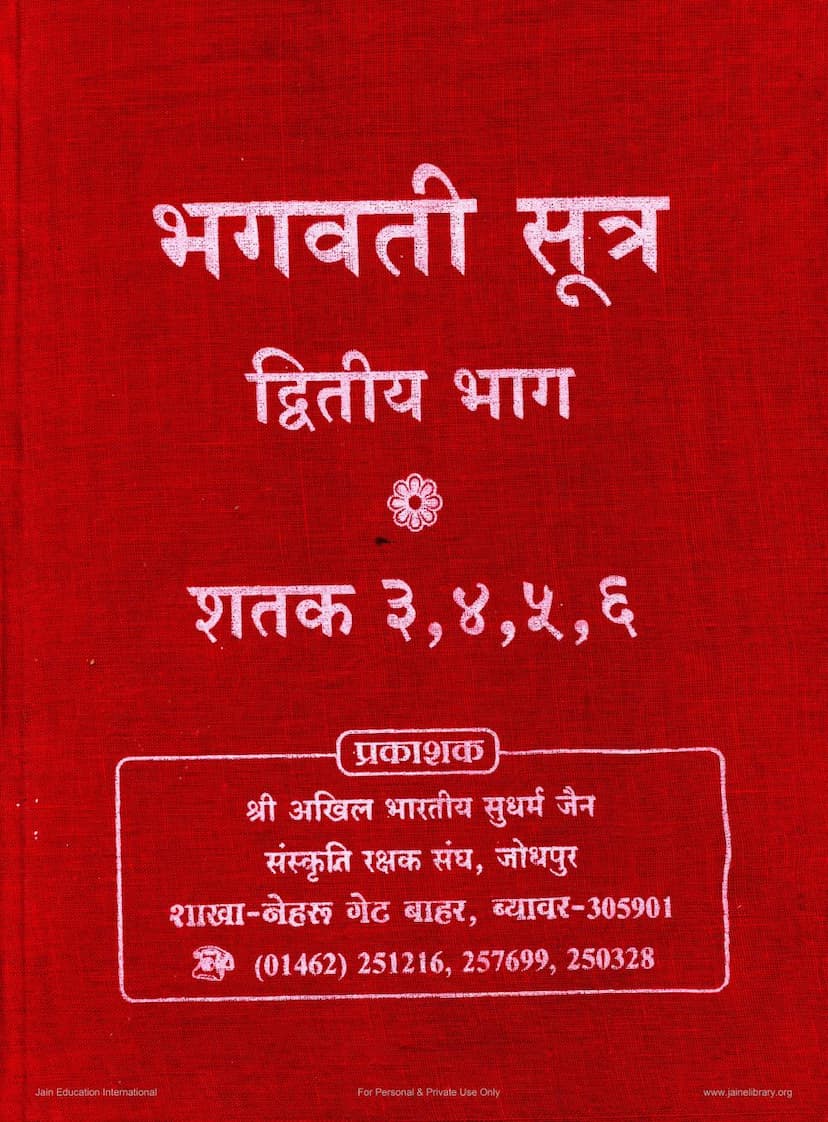Bhagvati Sutra Part 02
Added to library: September 1, 2025

Summary
Here's a comprehensive summary of the provided pages of the Bhagvati Sutra Part 02, focusing on the content of Shatakas 3, 4, 5, and 6, as detailed in the provided Hindi text:
Bhagvati Sutra Part 02: A Summary of Shatakas 3, 4, 5, and 6
This document is the second part of the Bhagvati Sutra, covering Shatakas (centuries) 3, 4, 5, and 6. Published by Shri Akhil Bharatiya Sudharm Jain Sanskriti Rakshak Sangh, Jodhpur, with a branch in Beawar, this volume is compiled and edited by Pandit Ghevarchand Banthiya "Veerputra." The publication is notably supported by Seth Jasvantlal Bhai Shah of Bombay, reflecting his deep interest in propagating Jain scriptures.
Overview of the Shatakas:
The Bhagvati Sutra, also known as Vyākhyāprajñapti Sutra, is a vast repository of Jain knowledge, presented through question-and-answer dialogues. This volume meticulously outlines the subject matter of each Shataka:
-
Shataka 3 (10 Uddeshakas):
- Uddeshaka 1: Describes the vikurvana (transformative powers) of Chamarendra (an Asura king).
- Uddeshaka 2: Discusses Chamarendra's utpāta (emergence/creation).
- Uddeshaka 3: Explains kriya (actions) like kāyiki (bodily actions).
- Uddeshaka 4: Addresses whether a monk can discern the vikurvana of celestial beings.
- Uddeshaka 5: Details the vikurvana by monks regarding forms of women and others.
- Uddeshaka 6: Describes city-related narratives.
- Uddeshaka 7: Focuses on Lokapālas (guardians of directions).
- Uddeshaka 8: Discusses lordships or authorities over Asura kumāras and other celestial beings.
- Uddeshaka 9: Covers the subjects of the senses (indriyas).
- Uddeshaka 10: Describes the assembly (parishad) of Chamarendra.
-
Shataka 4 (10 Uddeshakas):
- Uddeshakas 1-4: Detail matters related to celestial vehicles (vimānas).
- Uddeshakas 5-8: Describe royal capitals (rājadhānīs).
- Uddeshaka 9: Discusses Nairayikas (inhabitants of hells).
- Uddeshaka 10: Explains leshyas (subtle karmic matter coloring the soul).
-
Shataka 5 (10 Uddeshakas):
- Uddeshaka 1: Features question-and-answer sessions about the sun (Surya), which took place in Champanagari.
- Uddeshaka 2: Describes the nature of wind (Vāyu).
- Uddeshaka 3: Illustrates concepts using the example of a jālagranthi (a type of knot or entanglement).
- Uddeshaka 4: Presents question-and-answer sessions about sound (Shabda).
- Uddeshaka 5: Discusses Chhadmastha (unenlightened beings).
- Uddeshaka 6: Covers the topic of lifespan (Āyuṣya).
- Uddeshaka 7: Explains the vibration (kampana) of pudgalas (subtle matter).
- Uddeshaka 8: Details the questions posed by the nirgrantha-disciple Anagar.
- Uddeshaka 9: Describes Rajagriha city (Rājagriha).
- Uddeshaka 10: Discusses the moon (Chandra), with the description given in Champanagari.
-
Shataka 6 (10 Uddeshakas):
- Uddeshaka 1: Deals with Vedana (suffering/experience) and includes a parable about clothes to illustrate its connection with nirjara (karmic expulsion).
- Uddeshaka 2: Discusses Āhāra (food/sustenance).
- Uddeshaka 3: Explains Mahāsrava (great influx of karma) and Alpakarma (little karma).
- Uddeshaka 4: Covers Saparudesha (having many parts) and Jivapradarsha (soul regions).
- Uddeshaka 5: Focuses on Tamas-kaya (darkness-body/region) and Krishna-rajis (black lines/regions).
- Uddeshaka 6: Discusses Bhavya (future incarnates) and Shali (type of grain), and touches upon Prithvi (earth element).
- Uddeshaka 7: Explains Prithvi (earth element) and Shali (type of grain) and mentions concepts like gananiya-kala (calculable time) and upameya-kala (comparable time).
- Uddeshaka 8: Discusses Prithvi (earth element) and includes concepts of jiva-pradarsha (soul regions) and pratyakhyana (renunciation).
- Uddeshaka 9: Covers Karma and its sthiti (duration).
- Uddeshaka 10: Explains Anyayuthika Vaktavyata (statements of those following other paths).
Key Themes and Discussions:
The provided pages offer detailed explanations and dialogues concerning various aspects of Jain cosmology, ethics, and philosophy. Specific discussions include:
- Celestial Powers and Descriptions: Extensive details are provided about the powers of celestial beings like Chamarendra, Vairocana (Bali), Dharanendra, Shakra, and Ishana. Their vikurvana capabilities, their celestial abodes (vimanas), their subordinates (sāmanikas, lōkapālas, agaramahiṣīs), and their respective domains are elaborated upon. The text also includes details about their lifespans and previous lives, tracing their karmic actions that led to their current states.
- Nature of Elements and Karma: The text delves into the nature of elements like ap-kaya (water-bodies) and tamas-kaya (darkness-body), discussing their characteristics and origins. It also explains how different karmas (jñānāvaraṇīya, darśanāvaraṇīya, āyuṣya, etc.) are bound and their respective durations (sthiti), including concepts like abādhā (period without karmic fruition).
- Actions (Kriya) and Suffering (Vedana): Shataka 3 introduces the concept of five types of kriyas (kāyiki, adhikaraṇikī, prādvēṣikī, pāritāpanikī, prāṇātipātikī) and explains how they lead to karma. The interrelation between suffering (vedanā) and nirjara (karmic expulsion) is explored, using a clothing analogy.
- Time Calculations and Units: The text meticulously outlines units of time, from samaya (the smallest unit of time) to āvalikā, ucchvāsa, lāva, muhūrta, ahorātra, pakṣa, māsa, ṛtu, ayana, and saṃvatsara, up to complex calculations involving koṭi-koṭi sāgaropama for susama-susama and other eras.
- Other Topics: Discussions also cover the nature of human actions (māyi vs. amāyi), the significance of faith (samṛgdṛṣṭi vs. mithyādr̥ṣṭi), the powers of monks (anagāras), the characteristics of different types of hellish beings (nairayikas) and celestial beings (asurakumāras, vān-vyantaras, jyōtiṣikas, vaimānikas), the concept of leshyas, and the difference between chadmāstha (unenlightened) and kevalin (omniscient).
The document is rich in detail, providing specific examples and analogies to explain complex philosophical concepts. The emphasis on the charitable contribution of Seth Jasvantlal Bhai Shah highlights the Sangh's dedication to making this sacred literature accessible. The inclusion of a shuddhi-patra (errata) further indicates the meticulousness of the publication.